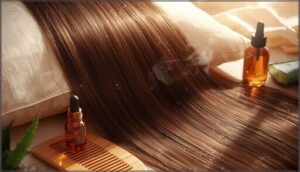This site is supported by our readers. We may earn a commission, at no cost to you, if you purchase through links.
Your hair drinks up moisture like a sponge, then loses it just as fast—leaving you with frizz, dryness, and strands that snap at the slightest provocation. This frustrating cycle points to high porosity hair, a condition where your cuticle layer has lifted or developed gaps that let water and products rush in freely, then escape just as quickly.
Whether you inherited this hair structure or created it through years of heat styling, bleaching, or chemical treatments, the result is the same: hair that feels rough, tangles easily, and demands a completely different care approach.
Understanding how your hair’s protective barrier works—and why those microscopic holes matter—gives you the power to lock in hydration, reduce breakage, and finally tame that persistent frizz.
Table Of Contents
- Key Takeaways
- What is High Porosity Hair?
- Key Characteristics of High Porosity Hair
- Causes of High Porosity Hair
- How to Test Your Hair’s Porosity
- Identifying High Porosity Hair in Daily Life
- Essential Care Tips for High Porosity Hair
- Preventing Damage and Improving Hair Health
- Frequently Asked Questions (FAQs)
- Conclusion
Key Takeaways
- High porosity hair has lifted or damaged cuticles that absorb moisture instantly but lose it just as fast, creating a cycle of frizz, dryness, and breakage that requires a completely different care approach than other hair types.
- You can identify high porosity hair through simple at-home tests like the float test or by observing daily signs such as instant water absorption, rapid drying times (1-2 hours), rough texture when touched, and excessive tangling with split ends appearing in over 70% of cases.
- The most effective care strategy combines deep conditioning once or twice weekly, sulfate-free cleansing every 5-7 days, protein treatments every 4-6 weeks to rebuild cuticles, and layering products (humectants followed by oils) to lock in moisture that would otherwise escape through damaged cuticle gaps.
- Preventing further damage requires limiting heat styling to once weekly below 160°C, extending chemical treatments to 8-10 weeks apart, using protective nighttime care like silk bonnets that reduce breakage by 26%, and balancing protein with moisture to avoid brittleness while maintaining flexibility.
What is High Porosity Hair?
Your hair might absorb products in seconds but feel dry an hour later—that’s the hallmark of high porosity hair. Understanding what this term actually means starts with looking at your hair’s structure and how it manages moisture.
Let’s break down the basics so you can identify what makes high porosity hair different from other types.
Definition of High Porosity Hair
High porosity hair has cuticles that are lifted or damaged, creating gaps that let moisture and products slip in quickly—but just as fast, they slip right out. Think of it like a screen door instead of a solid one: water flows through easily, but your hair can’t hold onto it.
High porosity hair absorbs moisture instantly through lifted cuticles but loses it just as fast, like water rushing through a screen door
This structure makes your strands more vulnerable to dryness and breakage. This often results in hair that’s prone to frizz.
How High Porosity Differs From Other Types
Understanding hair porosity types helps you choose the right care routine. Low porosity hair has tightly packed cuticles that resist moisture—water beads on the surface, drying takes forever, and products sit on top instead of sinking in.
Medium porosity offers balanced moisture retention with moderate drying time and better damage resistance.
In contrast, high porosity hair absorbs products instantly but loses hydration quickly, dries faster, and shows weaker cuticle structure that’s more prone to breakage. High porosity hair often benefits from occasional protein treatments to improve retention.
Hair Structure and Cuticle Layers
Think of your hair shaft like a roof with overlapping tiles—those are your cuticles. In high porosity hair, cuticle layer gaps and surface roughness allow water and products to rush in freely.
The cortex damage beneath these gaps, combined with reduced ceramide levels, explains the high moisture permeability. Your hair structure practically has holes in its protective barrier, letting hydration slip right through.
Key Characteristics of High Porosity Hair
Now that you know what high porosity hair is, you can spot it by looking at a few telltale traits. These characteristics show up in how your hair reacts to water, how it looks and feels, and the everyday problems you might face.
Let’s break down the main signs so you can recognize high porosity hair when you see it.
Moisture Absorption and Retention
Your hair drinks up moisture like a sponge, but keeping it there’s the real challenge. High porosity hair absorbs water 2-3 times faster than other types, yet loses up to 70% within two hours. Cuticle damage creates gaps that let hydration escape quickly.
Product layering with humectants and oils helps lock in moisture, while protein treatments can reduce water loss by 35%.
Texture and Appearance
You’ll notice the difference in how your hair feels and looks right away. Surface feel is often rough or coarse, while visual shine stays disappointingly dull. Color vibrancy fades faster, and curl definition weakens noticeably.
- Hair texture appears uneven with raised cuticles creating a bumpy surface
- Frizz develops easily, disrupting smooth styling attempts
- Strand thickness varies along individual hairs due to cuticle irregularities
- Light reflection decreases by measurable amounts compared to healthier hair
- Hair dryness shows through lackluster appearance despite regular conditioning
Common Issues (Frizz, Dryness, Breakage)
Why do over 90% of people with high porosity hair struggle with chronic frizz? Your raised cuticles grab moisture from humid air, then lose it fast—creating moisture imbalance and dryness. Structural weakness leads to breakage rates 30% higher than normal hair. You’ll face hair damage even when product performance falls short, with split ends showing up in 70% of cases.
| Issue | Impact on Your Hair |
|---|---|
| Frizz | Increases 68% in humidity; cuticles stay raised |
| Dryness | Loses 40% more moisture within two hours post-wash |
| Breakage | 50% higher during combing; split ends in 70% of cases |
Causes of High Porosity Hair
High porosity hair doesn’t just happen overnight. Sometimes you’re born with it, but more often, it’s something you develop over time through damage.
Let’s look at the main culprits behind those open, lifted cuticles.
Genetics and Natural Texture
Your genes shape your hair porosity types from day one. If you have coily or kinky hair texture, you’re more likely to have inherited cuticle structure with naturally spaced cuticle scales, leading to high porosity hair.
Studies show 50% of people with tightly textured hair possess genetically high porosity due to follicle genetics. Environmental amplification through humidity and pollution can intensify this trait, with prevalence rates reaching 35–45% in tested groups.
Chemical Processing Effects
Chemical treatments wreak havoc on your hair cuticle, lifting those protective layers wide open. Bleaching, perming, and coloring create structural changes that spike porosity by up to 200%, leaving your strands brittle with reduced tensile strength.
The more frequent the processing frequency, the worse the hair damage gets—monthly sessions can transform healthy hair into high porosity hair within just four to six treatments, greatly increasing hair breakage rates.
Heat Styling and Environmental Damage
Your blow dryer and flat iron do more than style—they assault cuticle integrity with every pass. Thermal thresholds above 175°C trigger permanent cuticle degradation, creating pathways for moisture loss that define high porosity hair.
UV radiation compounds this heat damage through photochemical breakdown, while pollution effects synergize with sunlight to accelerate hair damage.
This mechanical synergy demands strategic hair protection during hair styling.
How to Test Your Hair’s Porosity
Figuring out your hair’s porosity doesn’t require a salon visit or fancy equipment. You can run a few quick tests at home using things you already have on hand.
These simple methods will give you the answers you need to tailor your hair care routine properly.
The Float Test
The float test is one of the simplest hair porosity tests you can try at home. Drop a clean, product-free strand into a glass of room-temperature water and watch what happens.
High porosity hair generally sinks within a minute as water rushes through those lifted cuticles, while low porosity hair floats.
Just remember—interpretation caveats exist, since residue and hair texture can affect test accuracy and sinking speed.
The Spray Bottle Test
Another reliable hair porosity test you can try is the spray bottle test. Mist clean, dry hair with water from a consistent distance, then watch how it reacts. High porosity hair quickly absorbs the droplets with little beading, while low porosity hair forms visible beads that linger on the surface.
Here’s how to get the best results:
- Wash your hair first – Remove any products that could interfere with test accuracy.
- Spray multiple sections – Test your crown, sides, and nape to spot regional differences.
- Observe absorption speed – Fast saturation suggests high porosity; persistent beads indicate low porosity.
Performing the test on several areas helps you understand your hair’s true nature, since styling damage can create mixed porosity along your strands.
The Cuticle Test
While spray tests are helpful, the cuticle test gives you direct tactile feedback. Gently run your fingers up a single strand from tip to root. High porosity hair feels rough and bumpy because lifted cuticle scales create texture you can actually feel.
| What You Feel | Hair Porosity Indication |
|---|---|
| Smooth, glassy surface | Low porosity—cuticles lie flat |
| Slight texture, minimal resistance | Medium porosity—balanced cuticle structure |
| Rough, bumpy, uneven | High porosity—lifted or damaged cuticles |
| Varies along strand | Mixed porosity—ends more damaged than roots |
This simple method helps you identify cuticle damage without equipment, though professional microscopic analysis can reveal finer details about your hair’s true condition.
Identifying High Porosity Hair in Daily Life
You don’t need a lab test to spot high porosity hair—it shows up in everyday moments. From how your hair behaves in the shower to what happens when you reach for a brush, your routine holds all the clues.
Let’s look at the telltale signs that reveal your hair’s porosity in real time.
Signs During Washing and Styling
When you’re washing and styling your hair, high porosity hair sends clear signals. Here’s what you’ll notice:
- Instant Water Absorption – Your strands soak up water within seconds during washing, while frizz appears almost immediately after towel-drying, making it tough to manage.
- Quick Product Absorption – Hair products, conditioners, and treatments disappear into your hair in under a minute, requiring frequent reapplication.
- Detangling Breakage – You’ll find considerably more strands in your comb or brush after washing, with tangles leading to noticeable breakage and split ends.
Drying Patterns and Product Absorption
Rapid drying is one of the most telling behavioral indicators of high porosity hair. Your strands can dry completely within 1 to 2 hours after washing, compared to 6 to 12 hours for low porosity types.
Product absorption happens just as fast—leave-in conditioners vanish within five minutes, often requiring you to reapply multiple times daily for lasting hair hydration and moisture retention.
Split Ends and Tangles
Because of raised cuticles, your high porosity hair is 2–3 times more likely to tangle, especially after washing. Split ends appear in over 70% of cases, worsening hair breakage without preventive trimming every 6–12 weeks.
Physical mechanisms include rapid moisture loss and cuticle friction, both factors affecting long-term hair care success. Detangling practices using wide-tooth combs reduce breakage by 40%.
Essential Care Tips for High Porosity Hair
Once you know your hair has high porosity, the next step is building a care routine that actually works. The right approach can help you lock in moisture, reduce breakage, and bring your hair back to life.
Here are three essential strategies that make a real difference in managing high porosity hair.
Moisturizing and Hydration Strategies
Your high porosity hair needs moisture that actually stays put. Start with deep conditioning once or twice weekly to rebuild softness and lock in hydration.
Follow with leave-in conditioners for ongoing moisture retention throughout the day. Layer humectants like glycerin to attract water, then seal everything in with oils or butters as an occlusive barrier.
This prevents rapid water loss through those raised cuticles.
Gentle Cleansing and Shampooing
Your cleansing frequency matters—aim for every 5–7 days to prevent moisture loss.
Choose sulfate-free shampoo with gentle ingredients like aloe vera and glycerin to support scalp health without stripping natural oils.
Focus hair products ingredients on your scalp rather than lengths, using warm water and light pressure.
This high porosity hair cleansing technique minimizes cuticle damage while removing buildup effectively.
Regular Trimming and Detangling
Split end prevention starts with strategy. Trim your hair every 6–8 weeks to stop damage from traveling up the shaft, making tangles and breakage reduction far easier.
For detangling techniques that protect high porosity hair:
- Work from ends upward using wide-tooth combs on wet, conditioned strands
- Apply leave-in products before tool selection to reduce friction
- Finger-detangle first to minimize hair damage prevention needs
Preventing Damage and Improving Hair Health
Once you’ve established a solid care routine, the next step is protecting what you’ve worked to restore. High porosity hair thrives when you take preventive measures that shield it from further damage.
Let’s look at three key strategies that will help you maintain healthier, stronger strands over time.
Reducing Heat and Chemical Exposure
Think of heat styling and chemical treatments as your hair’s worst enemies—they crack open those cuticles even wider. For high porosity hair already struggling with damage, limit flat irons and curling wands to once weekly.
Keep protective temperature settings below 160°C, and extend chemical processing frequency to at least 8–10 weeks between services. Choose less aggressive options like semi-permanent color, and build in rest periods with deep conditioning care between treatments.
Protective Styling and Nighttime Care
Safeguarding your high porosity hair overnight makes all the difference. Sleeping with a silk bonnet reduces friction-induced breakage by 26% and keeps morning frizz under control.
Pair this with nighttime moisture layering—apply leave-in conditioner, seal with oil, then add cream before bed. These protective style benefits and product application methods work together to improve hair hydration, cut tangling by 31%, and support better hair maintenance without constant styling stress.
Protein Treatments and Cuticle Repair
Protein treatments rebuild weakened cuticles, but timing matters. Apply hydrolyzed keratin every 4–6 weeks to prevent protein overload—excessive use makes hair brittle and prone to breakage. These repair mechanisms work by filling gaps in damaged cuticles, boosting tensile strength by up to 14%.
Balance complementary strategies: follow treatments with moisture-rich conditioners to maintain flexibility. Your high porosity hair needs both structure and hydration for lasting damage repair.
Frequently Asked Questions (FAQs)
What oils work best for high porosity hair?
Coconut oil penetrates deeply, reducing protein loss by up to 36%. Castor oil seals moisture effectively.
Argan oil repairs cuticles with antioxidants. Avocado oil boosts elasticity.
Grapeseed oil offers lightweight UV protection for healthier strands.
How often should I deep condition?
Most high porosity hair thrives with deep conditioning once weekly. If your strands feel exceptionally dry, twice-weekly treatments help, but watch for product buildup or limpness—clear signs you’re overdoing it.
Can high porosity hair be reversed or fixed?
Improved moisture retention occurs in about two-thirds of treated cases, though complete cuticle regeneration isn’t possible once damage sets in.
Protein integration and targeted treatments help, but high porosity hair requires ongoing management rather than permanent reversal.
What ingredients should I avoid in products?
When choosing hair products, steer clear of harsh sulfates like SLS, drying alcohols such as isopropyl alcohol, allergen fragrances, heavy silicones, and strong chemicals that strip moisture and cause buildup or irritation.
Does water temperature affect high porosity hair?
Hot water damages even healthy hair, yet it’s what most people use.
For high porosity hair, lukewarm water around 37–38°C helps balance cleansing with cuticle protection, preventing moisture loss and breakage.
Conclusion
Think of Maya, who spent years fighting her frizz with heavy oils that never quite worked. Once she recognized her high porosity hair and switched to protein treatments and water-based sealants, her strands transformed within weeks.
Your hair’s structure doesn’t have to limit you—it simply needs the right strategy. When you match your routine to those open cuticles, you’ll finally see the smooth, hydrated results you’ve been chasing.
- https://natureslittlesecret.net/blogs/healthy-hair-education/hair-porosity-explained-low-normal-high-porosity-truths
- https://www.health.com/high-porosity-hair-11730553
- https://keravada.com/blogs/natural-hair-news/the-hidden-science-behind-high-porosity-hair-in-african-american-women-groundbreaking-solutions-you-havent-heard-of/
- https://pmc.ncbi.nlm.nih.gov/articles/PMC12513242/
- https://pubmed.ncbi.nlm.nih.gov/35377477/












